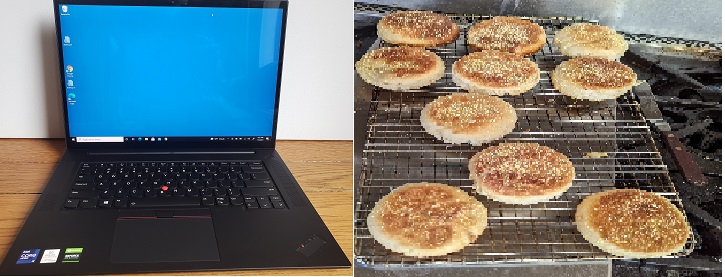ThinkPad T490s Review
The latest in a long line of slim-format ThinkPads
This review is an analysis of the next generation of T-series ThinkPads in the slim profile. When a long-time user visualizes a ThinkPad, the image that comes to mind is the T-series laptop, which has been the standard, portable business computer for many years.
The slim T-series machines were introduced with the T400s that began to appear in 2010 and continued with the very similar T410s the following year. The T410s utilized the first generation of Intel’s “Core” (what Intel calls the Brand) processors and also introduced the I3, I5 and I7 distinctions (what Intel calls the Brand Modifier). These first two slim machines were about 12mm (½ inch) thinner and about 500gm (1.1 lb.) lighter than the T400 and T410 machines. Being thinner and lighter necessitated some compromises; there were fewer ports, shorter battery life, a soldered CPU and a strange, little 1.8” hard disk drive. The disk drive was the biggest problem from my point of view. I found them to be not very reliable, and they were small-capacity and expensive to replace. In 2012, Intel introduced the 2nd generation Core processor (Sandy Bridge) and the T410 and T410s were replaced by the T420 and T420s. Again, the slim models were thinner and lighter with soldered CPUs, but the 1.8” drives were replaced by newly introduced, single-platter 2.5” drives that were 7mm thick, rather than the more common 9.5mm, 2-platter drives. The same pattern continued every year, with the 2nd digit of the model, the 4th digit of the year and Intel’s generation number all matching. The generation number appears in the CPU designation after the I3, I5 or I7. For example, I5-4200m is a generation “4” CPU, introduced in 2014. The mainstream T-series ThinkPads that used that CPU were the T440 and T440s. the “S” models continued to be slimmer and lighter, but by 2014, both the “normal” and slim models featured soldered CPUs and 7mm drives. In keeping with the pattern, 2017 featured Kaby Lake, 7th generation CPUs, but later that year, it was announced that subsequent models were delayed and that 2018 would bring something called Kaby Lake Refresh. Even though Intel’s code name was similar to the previous year, the new processors had the generation “8” in their designations and turned out to be as much as 40% faster than the 7th generation processors, the first real speed increase since the Haswell (4th generation) CPUs. This year, Kaby Lake Refresh is being replaced by Whiskey Lake, but the designation (generation?) is still “8”. The last digit of the designation seems to be a “5”, rather than “0” on the Whiskey Lake CPUs. I’m not sure what to expect later this year or next year.
The machine I tested is based on an Intel i7-8565U eighth-generation Whiskey Lake 1.8 gHz quad-core CPU. It has 16 GB of DDR4 memory and a bright 14” FHD (1920X1080) IPS screen. Graphics functions relied on the Intel UHD Graphics 620 functions that are built into the CPU. There were two “normal” USB3.1 Gen1 ports, one USB Type-C port and one Thunderbolt™ 3 port. The Thunderbolt port and USB Type-C can double as the power input connector. There was also an audio combo jack, an HDMI port and a proprietary port to connect to a Side Dock. Networking is handled by an Intel Wireless-AC 9560 adapter that combines WiFi 2 x 2 AC and Bluetooth® 5.0. In order to save space, the wireless adapter, CPU and memory are all soldered to the motherboard. The machine came loaded with Windows 10 Professional. For storage, the computer has a fast, Lenovo-branded NVMe LENSE40512GMSP34MESTB3A SSD. The T480s also has dual array, far-field microphones, NFC, a fingerprint reader and two webcams. In addition to the normal webcam, it came with an infra-red camera for facial recognition security. The cameras have a mechanical shutter for privacy. On the rear, there is a slot for a SIM card. My test machine also came with an optional Fibocom L830EB WWAN card and a smart card reader.
The T490s I tested weighed 1330 gm or 46.9 oz. The weights do not include the charger. There may be some variations depending on configuration.
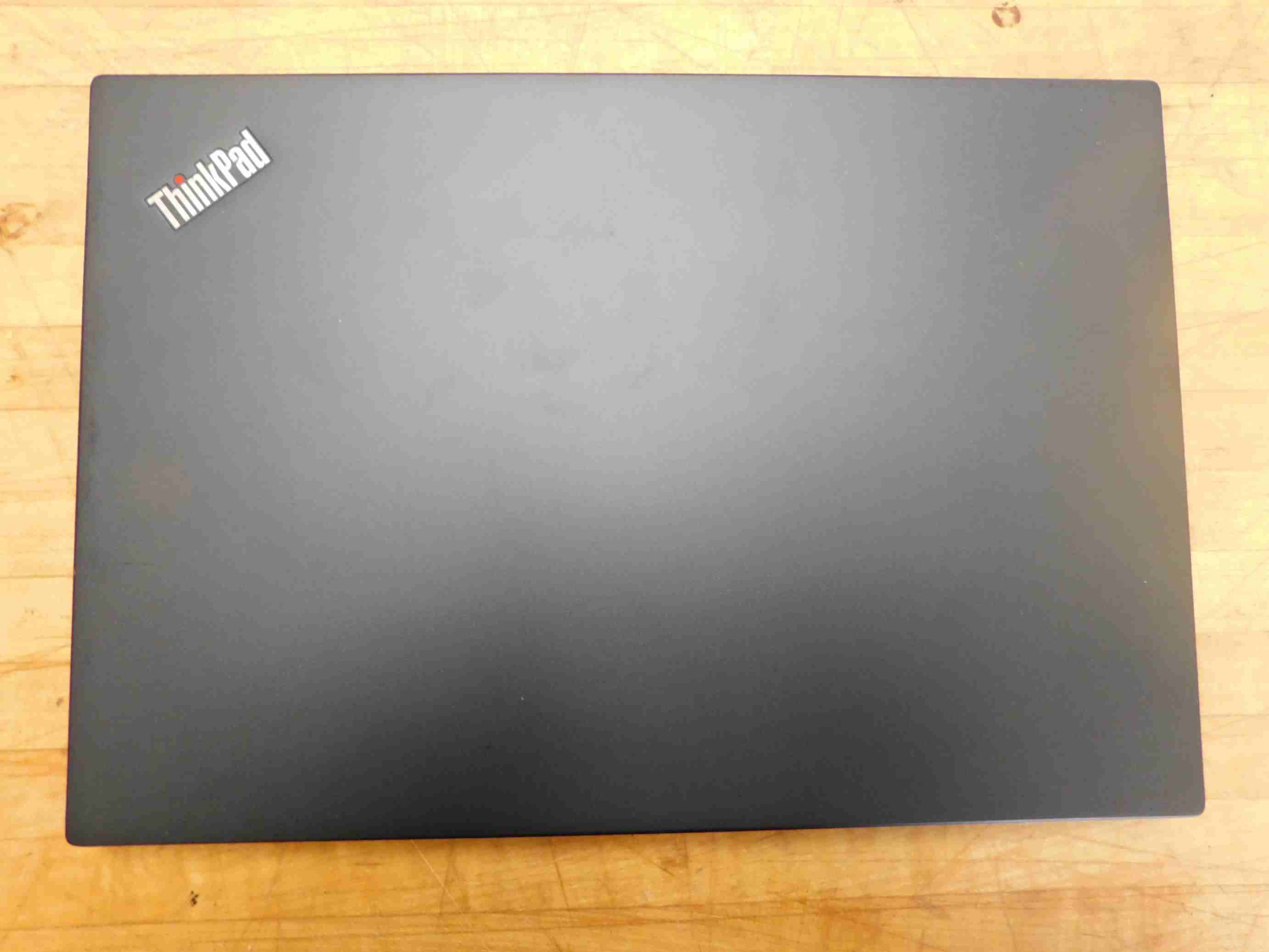 Figure 1: Top cover
Figure 1: Top cover
 Figure 2: Bottom cover
Figure 2: Bottom cover

Figure 3: Left side ports
 Figure 4: Right side ports
Figure 4: Right side ports

Figure 5: Rear port
My first impressions were positive. After unpacking, before I turned it on, I inspected the machine for any shipping damage or visible defects and found none.
I set the machine up and plugged it in. I booted into the BIOS to set the date and time, and to confirm that the processor, memory and disk storage were correct. I then booted normally and connected the machine to my Lenovo ID and Microsoft ID. I installed Office 365 and tested those applications. As I expected, everything worked correctly; Office tends to run on any Windows machine. Being a business computer, the machine supports TPM 2.0 for encryption and it also has a fingerprint reader. I put passwords on through the BIOS and turned on “Windows Hello”. Everything worked perfectly. My T490s has an infrared camera with face recognition, which is integrated into Windows Hello. I set that up as well. I sometimes have glasses on, and I sometimes wear a hat. I took four pictures, with and without each. The process seemed to work without any issues. The fingerprint sensor has been integrated into the pre-desktop authentication, so that at power up, a single swipe could supply my power-on password, ATA passwords and Windows passwords. The face recognition is only integrated into Windows. I don’t know enough about the process to know if integration into the pre-desktop authentication might be possible at some later time. I have heard rumors that Microsoft was looking into it, whatever that means.
I was impressed with the clarity and viewing angles from the IPS screen. There was no backlight bleed and the colors were crisp, including the blacks and the whites. Based on the screen resolution and the size of the screen, the default under Display Settings was to render text and icons at 150%. I prefer a little more information per page, and the screen was so clear that I was comfortable with a smaller number. I tried both 125 and 100% and I think I settled on 125%. My test machine has the basic 250 nit FHD screen. According to documentation, there will be an optional 300 nit FHD IPS touchscreen, a 400 nit FHD IPS screen with or without a privacy guard and a 500 nit WQHD IPS screen with Dolby Vision™
I liked the keyboard. There was a clear, positive feedback when the key “clicked”. On many machines with a short key travel, I’m never certain that a key stroke has registered. I had no problem with “key bounce”, where the user tries to hit a key once and ends up with two (or more) of the same character. The area around the keyboard was slightly depressed, presumably to eliminate any problems with keyboard marks on the LCD.
The machine looks like a traditional Lenovo ThinkPad.
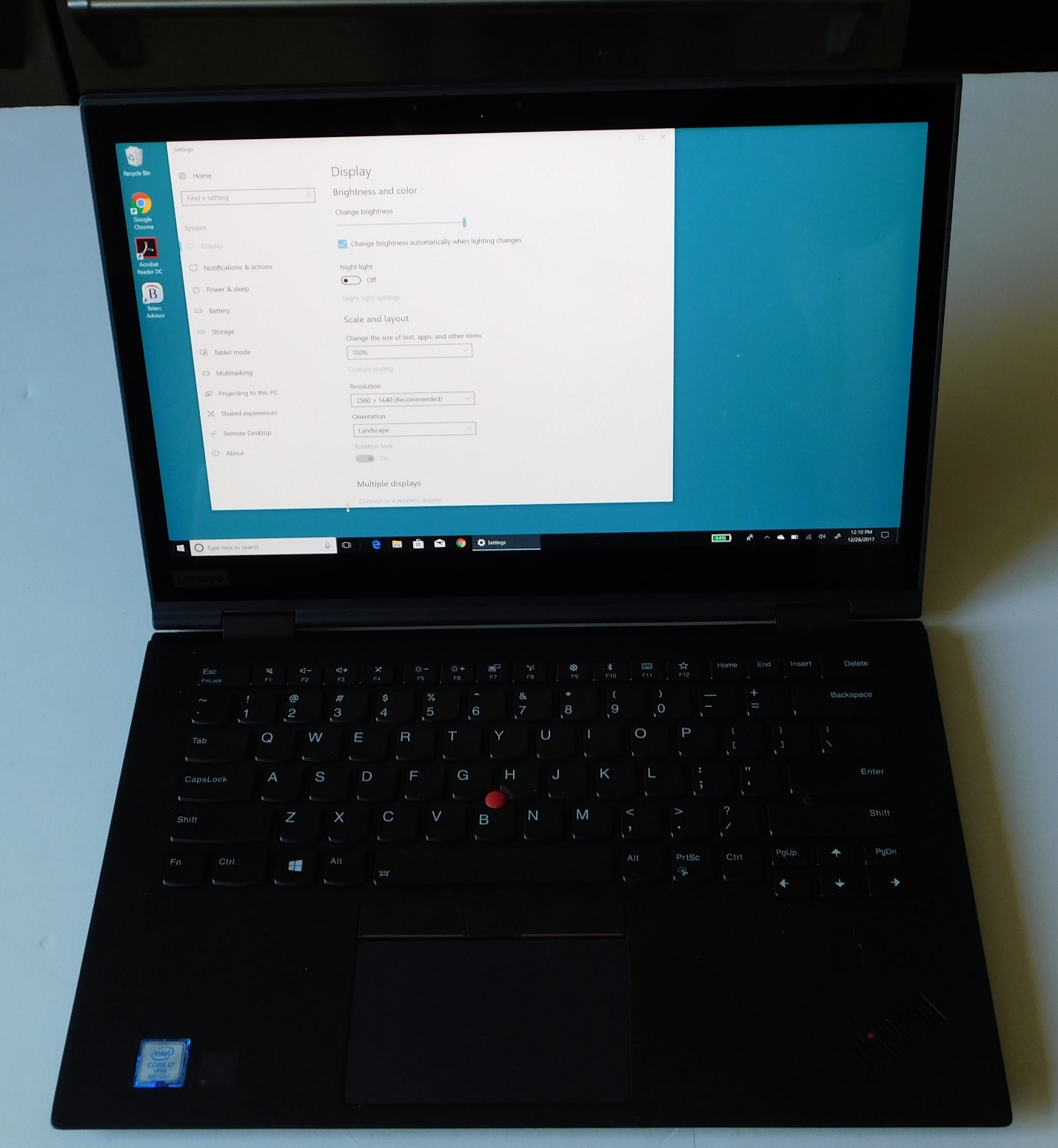
Figure 6: Running
The T490s uses DDR4 memory, which runs at 1.2V, and it supports a new standby power mode, available in the 7th generation and later Core processors. This power state needs far fewer refresh cycles in standby mode, thus dramatically lowering the power drain while the machine is sleeping.
I looked through the specifications to determine the year-to-year changes and similarities between last year’s T480s and the T490s and there are several notable items. The T490s is about 2mm thinner and a little lighter, about 10 grams. Both machines say they are powered by 8th generation Intel Core processors, but the T480s had a Kaby Lake R CPU vs. the Whiskey Lake CPU in the T490s. Both laptops use Intel UHD 620 graphics. The T480s was also available with nVIDIA MX150 graphics. The discrete graphics option is not available on the T490s. Looking at the specifications for the T480 vs. T490 (no “S”) I can see that the MX150 in the T480 was replaced by the mVIDIA MX250 in this year’s T490. I might guess that something about the MX250 was not consistent with the thinner case of the T490s, but that is just my speculation. The T490s has a “normal” webcam plus an optional IR camera for facial recognition. There is a ThinkShutter for privacy (blocks camera’s view). The T480s had the same camera options, but the ThinkShutter was missing if the IR camera option was chosen. The T480s had memory soldered to the motherboard plus an available slot for expansion; there is no slot on the T490s. The RJ45 (Ethernet) port and SD card slot on the T480s were eliminated this year, perhaps as a result of the thinner case, but, again, that is my speculation. Users who need the discrete graphics, SD card slot or Ethernet connector might be better-served choosing the slightly thicker and heavier T490. I have not seen a T490, but it should be noted that the specifications indicate that the T490 is a little thinner and lighter than last year’s T480s. The microphones were upgraded this year in that they are now designated “far field”, which should improve voice recognition, but I tend not to talk to my computers, so I am not really able to do a good comparison. The T490s added a screen option for a Privacy Guard and a Privacy Alert, but my test machine did not come with that option, so I can offer no comments. The Bluetooth was upgraded from version 4 to 5.1; the wireless card was also upgraded, but I had no way to test the ramifications of the upgrades. I can say that the wireless and Bluetooth worked in my tests. The WWAN card (cellular modem) was also upgraded, but I had no available SIM card to do any sort of testing. NFC (near field communication) was added this year, but that is another feature I do not use. The T490s added the option of a silver-colored case. I haven’t seen one so I cannot comment further.
People frequently ask me about “upgradability”. In general, laptops are less upgradable than desktops, and compact laptops are less upgradable than larger ones. As computers get smaller and thinner, memory, CPUs and sometimes even disk storage cannot be changed as they are integrated into or soldered onto the motherboard. In the ThinkPad T490s, CPU, wireless adapter and memory are soldered, and the SSD is a separate M.2 card. The battery is inside the machine and can be disconnected for service via the BIOS, without opening the case. I suggest that you would be better off not opening the machine unless you really need to do it. Having said that, the bottom cover is held on by 5 captive (they don’t come out) screws. The lid lifts off from the hinge side. There are tiny tabs all around, and if you are not familiar with this sort of cover, it is easy to bend or break the tabs. Once the tabs are bent or broken, the cover will never fit correctly. I believe that you should buy a machine with a disk big enough for your needs, rather than planning to upgrade later. If you really want to know how it looks inside, you can examine my pictures:
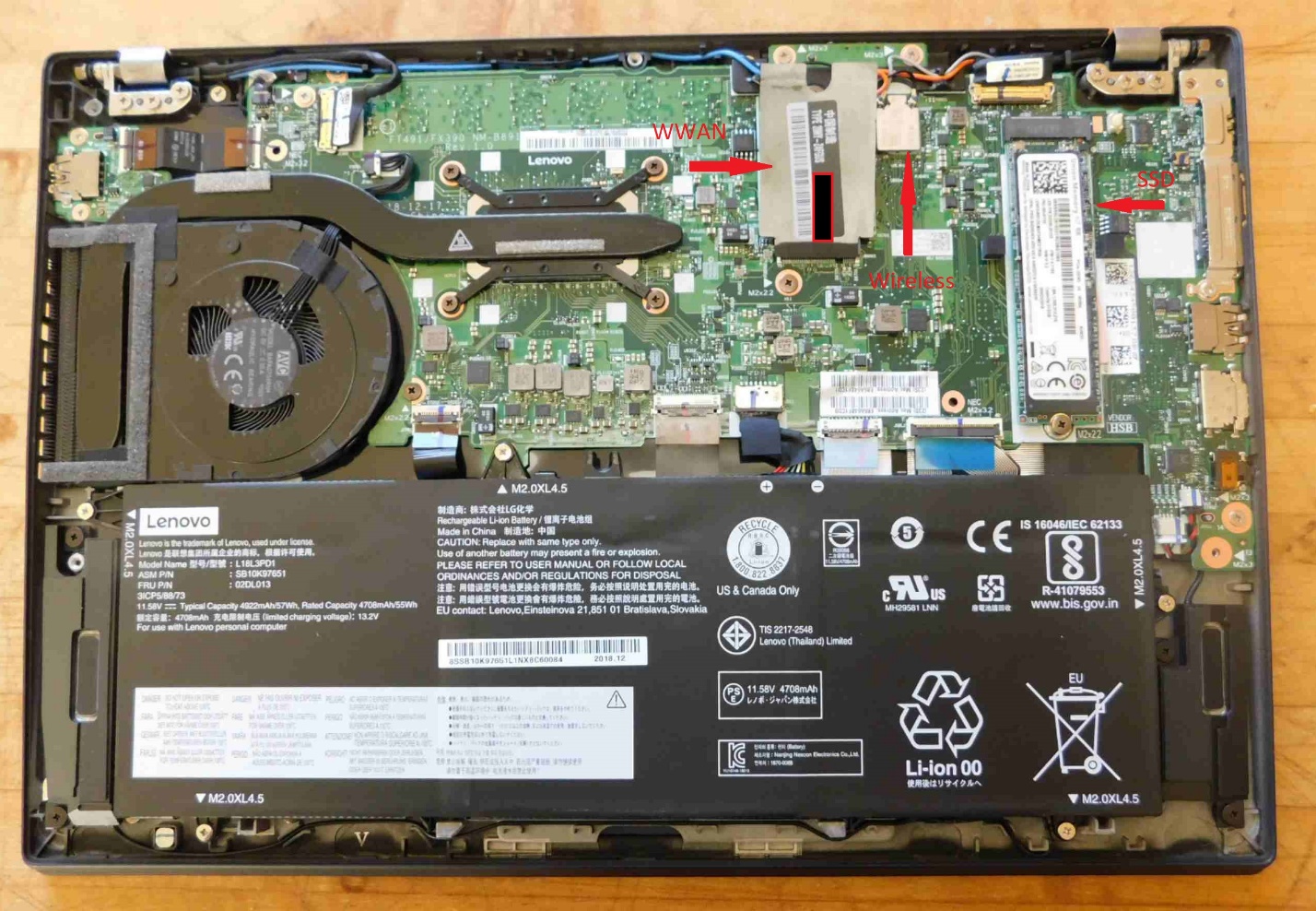
Figure 7: Overall view
You can see the large, 57 watt-hour battery. The WWAN card is under a plastic cover to the right of the CPU fan. A common question is whether an M.2 SSD can be fitted into the WWAN slot. In this case, I believe the answer is “no”. I tried installing a PCIe SSD into the WWAN slot, and it wasn’t recognized by either the BIOS, or in Windows, by the device manager. I believe an SSD did work in the T480s. Mine is a pre-release version with a very early BIOS. I have no way to know if an SSD might be made visible by a BIOS update.
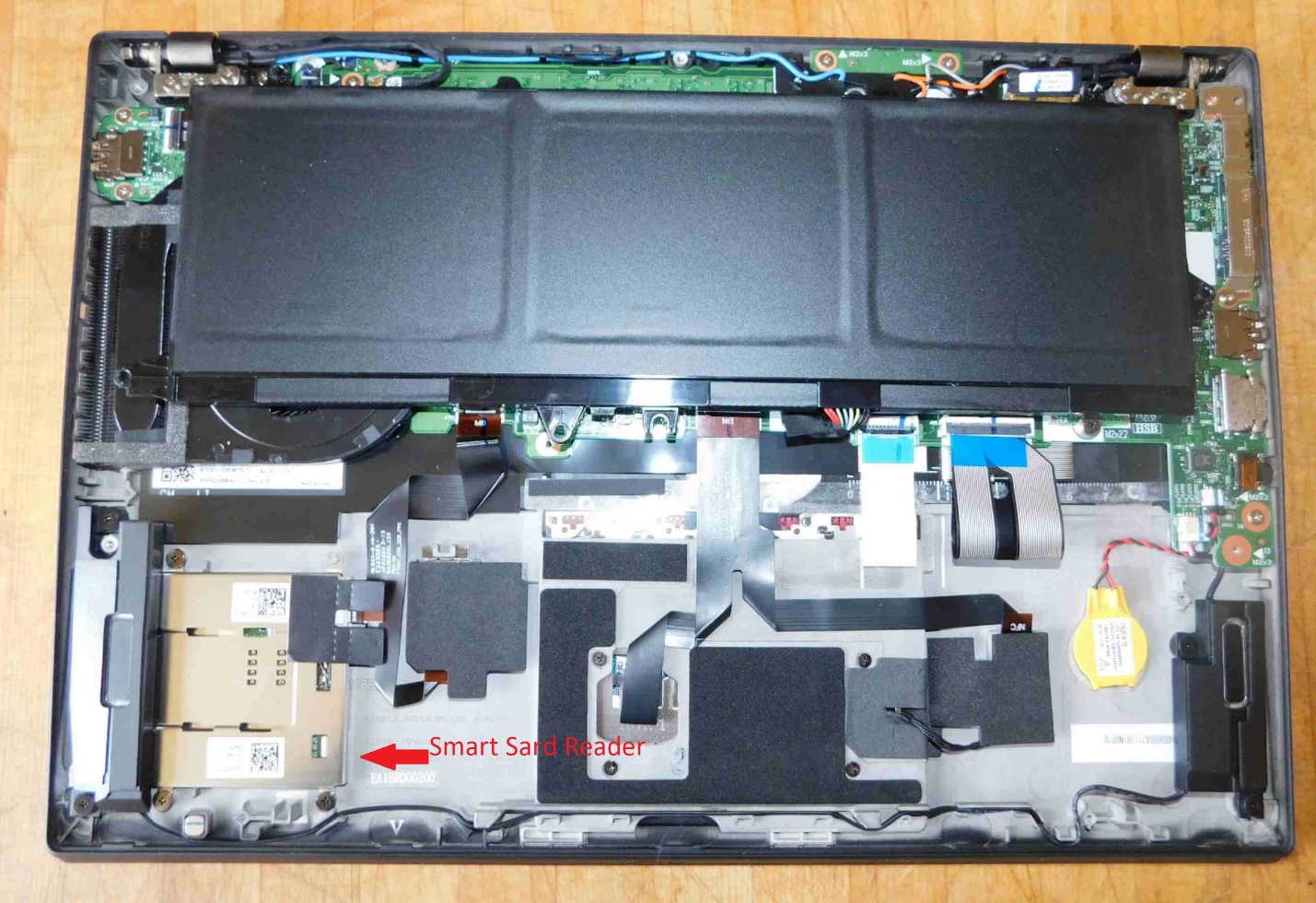
Figure 8: Under the battery
The only part you might need to upgrade is the SSD. The SSD in my machine is a Lenovo-branded 512GB NVMe drive. If you decide to upgrade the SSD, it takes a type “M” connector.

Figure 9: SSD
I always want to be sure that I won’t run into a problem related to overheating or excessive fan noise. For testing, I often use TPFanControl to monitor temperatures. I ran Prime95 to exercise the CPU and watched the temperatures. After about 15 minutes, the temperatures stabilized around 77˚C, which is warm, but not excessively warm, especially for an I7 processor and a thin case. Fan noise was never a problem.
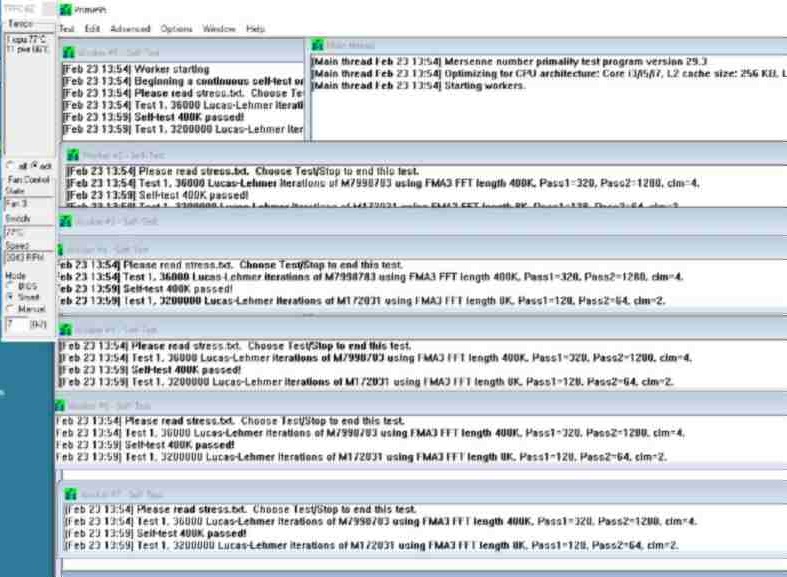
Figure 10: Prime95 and TPFanControl
I wanted to do some sort of speed comparisons to try to quantify and changes between the Kaby Lake R machine vs. the Whiskey Lake computer, but I did not have a T480s for a perfect test. I have an X1 Yoga Gen 3 from last year, which is VERY similar in terms of CPU, chipset and graphics. The only difference is in the memory; the X1 Yoga uses LPDDR3 memory, and the T480s and T490s both use DDR4. I would expect differences to be minimal. Both machines have 16GB of memory and use Intel UHD 620 graphics. The Kaby Lake R CPU is an Intel i7-8650u processor that has a base clock speed of 1.9 gHz and a turbo speed of up to 4.2 gHz. The Whiskey Lake CPU in my T490s has a slightly slower base speed and a higher turbo speed, 1.8 gHz and 4.6 gHz, respectively. Both CPUs have 4 physical cores, with 2 logical threads per core. I would expect that the slightly faster base clock speed might help throughput if all the threads are being used and that the higher turbo speed would improve single thread processing. The cache sizes are the same. There is one other improvement in the Whiskey Lake architecture; the number of PCIe lanes was increased from 12 to 16. That change might benefit SSD throughput, in some minor, nebulous way.
I want to mention one more thing. The memory benchmark I ran was using a bootable USB drive, so nothing else was running. All the other tests were run under Windows, so there are background tasks running that may affect results to a slight degree.
For memory access, it turned out that both computers’ CPUs could fetch memory as fast as the memory controller and bus could provide it. Additional cores and threads didn’t seem to matter. The T490s machine’s memory runs at 2400 mHz while the Gen 3’s memory runs at 2133 mHz. I used a stand-alone (bootable) version of Memtest86 to test memory speed. I simply let it run one full test and compared the elapsed times. The T490s machine was faster by an amount proportional to the difference in memory clock speed. It completed in about 32 minutes and the X1 Yoga took about a minute longer. I did notice one interesting thing that is not directly related to this review. I ran the same version of Memtest86 last year on the same X1 Yoga Gen3 when I compared it to a Gen2 X1 Yoga. This time, the Memtest took about 20 seconds longer than the same test a year ago. At first, I was wondering about things like the proximity to the full moon, but I remembered that since the first test, there was a BIOS release related to Intel’s addressing a security flaw, in which they made their instruction look-ahead speculation less aggressive. That change could be an explanation. It could also be that there is some variation in times on successive tests.

Figure 11: Memory test
I use Furmark to test graphics performance. Furmark does a very complicated set of rotations and gyrations and generates a full-motion graphic. On both machines, I ran Furmark in full screen mode at the native resolution for the LCD. The two machines both used Intel UHD 620 graphics, but the X1 Yoga has a higher screen resolution (2560X1440 vs. 1920X1080). I’m not sure how much the added complexity of the denser screen affects the frame rate. At the end, Furmark gives a summary, with the important feature being the number of frames per second (FPS) rendered.
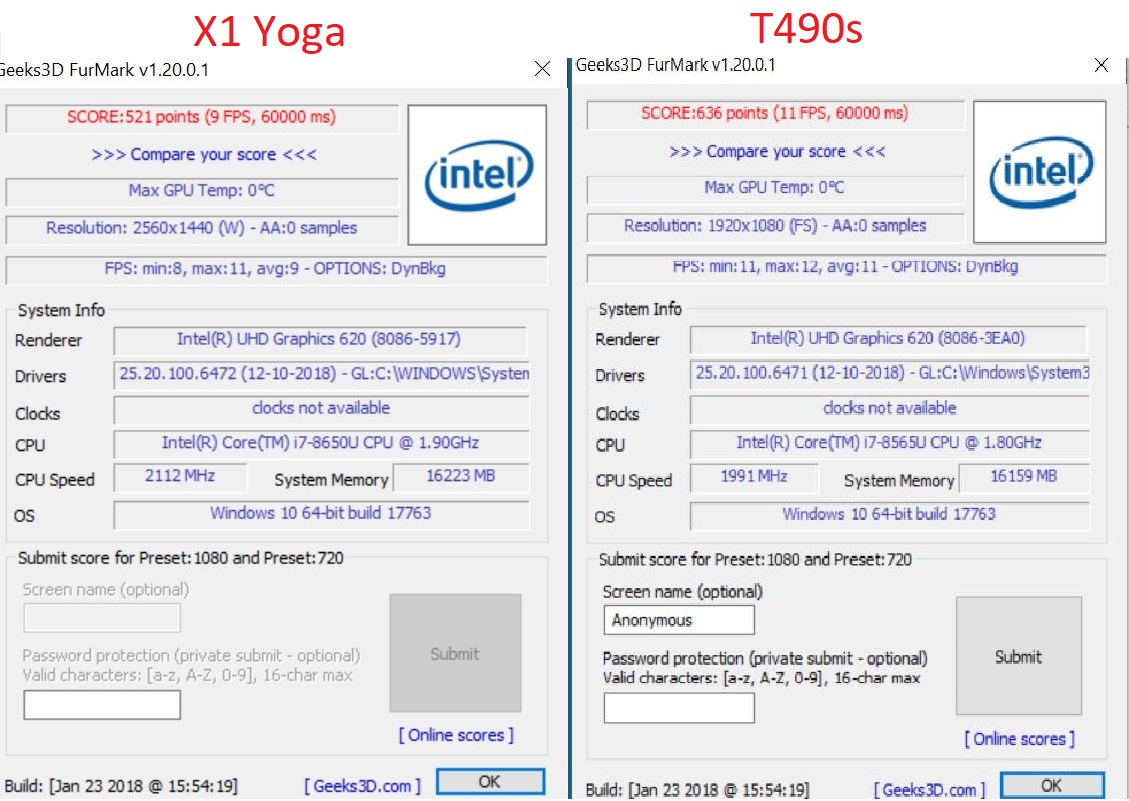
Figure 12 Graphics benchmark
It turned out that the program’s numeric score on the T490s was about 20% higher than the X1 Yoga (636 vs. 521), and the frames-per-second figure increased from 9 FPS to 11 FPS). I don’t know the reason, but it may be related to the different screen resolution.
I like to use Novabench to test overall performance. In general, the T490s scores were slightly higher than the scores from the X1 Yoga from last year. Near the top of the output display, Novabench lists the CPU speed. For processors that support Turbo Boost, this number represents the actual speed that was achieved. The speed shown may be different from either the base frequency or the Turbo Boost frequency.
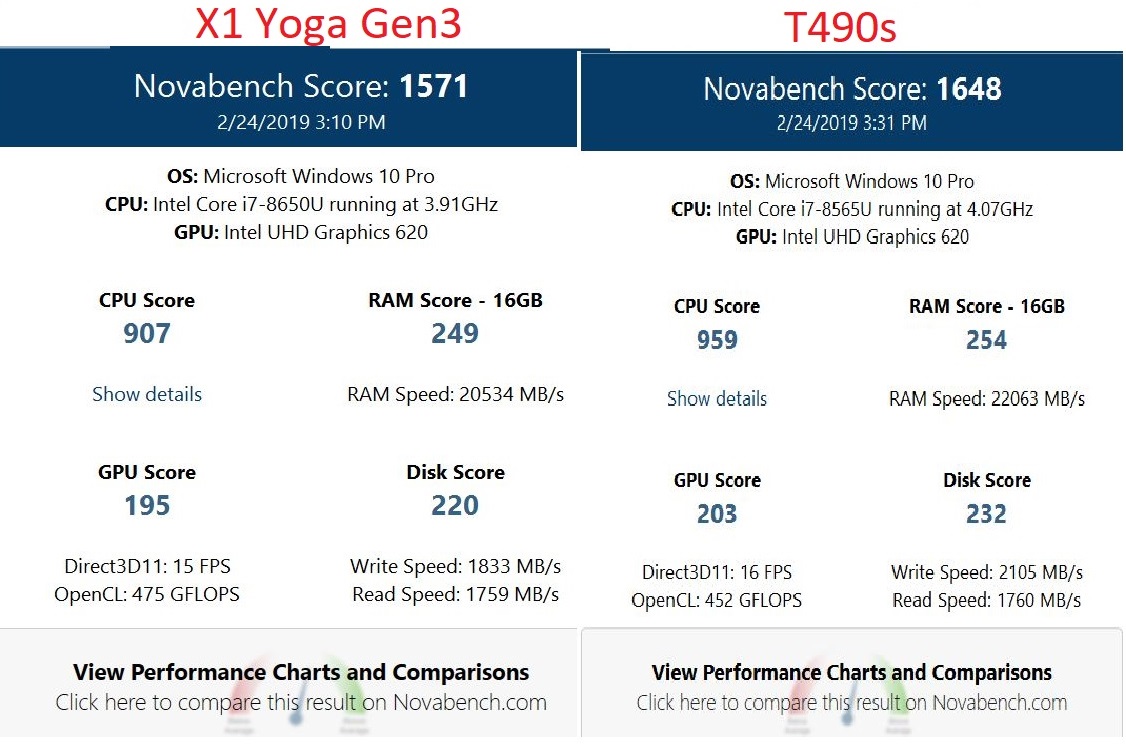
Figure 13: Overall performance
I also like to run a single-thread performance test to see how well a machine will perform when doing computations that cannot be spread out among multiple threads. Also, some older software (and some new software) is not designed to use multiple threads. Normally, CPUs with more cores tend to have a lower base clock speed, so one would expect them to perform less well on a single-thread test. “Normally”, doesn’t directly apply here, though, because both i7 processors can use Turbo Boost, a feature that lets CPUs work faster than they are expected to run. Even though the real clock frequency on the X1 Yoga machine was faster (1.9 gHz vs. 1.8 gHz), the Turbo frequency was slightly slower (4.2 gHz vs. 4.6 gHz). Some things depend on the base frequency and some things depend on the Turbo frequency. Turbo Boost is on a growing list of technologies that I “understand” by attributing their actions to magic, but, simply, Turbo Boost allows more than one core to help with a demanding thread at a time when all available threads are not being exercised. The program I use for single-thread CPU testing is SuperPi. This program forces the use of a single thread and calculates the first 32,000,000 digits of Pi. Just to make sure it is right, it goes through the process 24 times and writes the digits to a file, in case you want to know the digits or to check the results using a hand-held calculator. The T490s was faster, probably due to the faster Turbo Boost speed (just over 8 minutes vs. just over 9 minutes).
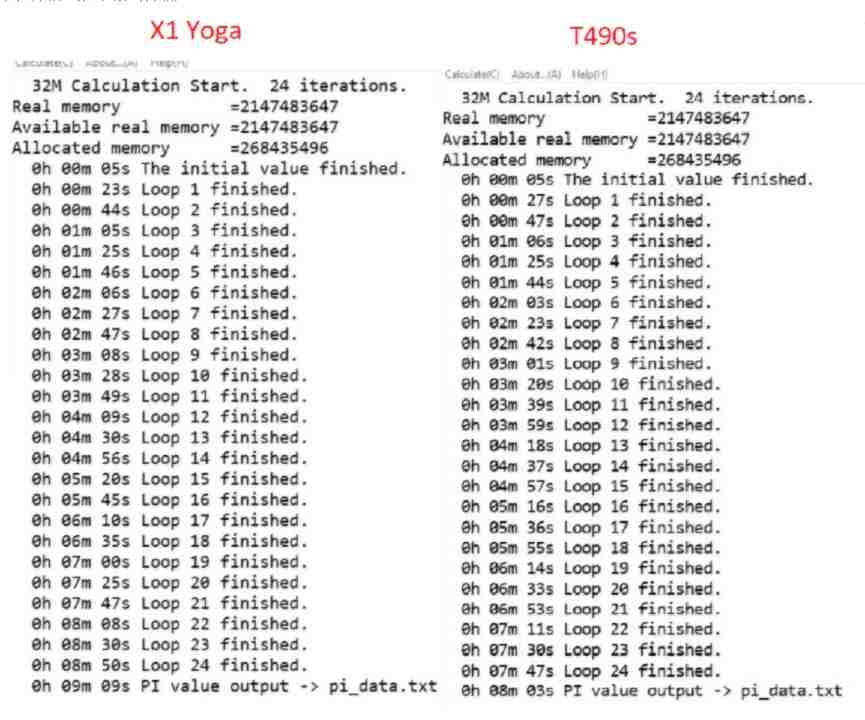
Figure 14: Single-thread
Earlier, I had run Prime95 with TPFanControl to confirm that both machines were able to survive a stress test in all threads and remain cool enough to be stable. I sometimes use a different program, Intel Burn Test for the same reason. Intel Burn Test goes through an extensive set of algorithms and calculates some number and compares the calculated number to the expected result. It then repeats the process 10 times and announces that, if your machine survived the test, it should be stable doing any real work. In addition, however, it indicates how long each of the iterations took. Less time would indicate a faster processor. If the times get longer as you go through the 10 cycles, it would indicate that the CPU was being throttled down due to heat. With that in mind, I decided to run the program on both machines to see if I could learn something. This time, I used Core Temp to monitor temperatures, rather than TPFanControl, for no particular reason.
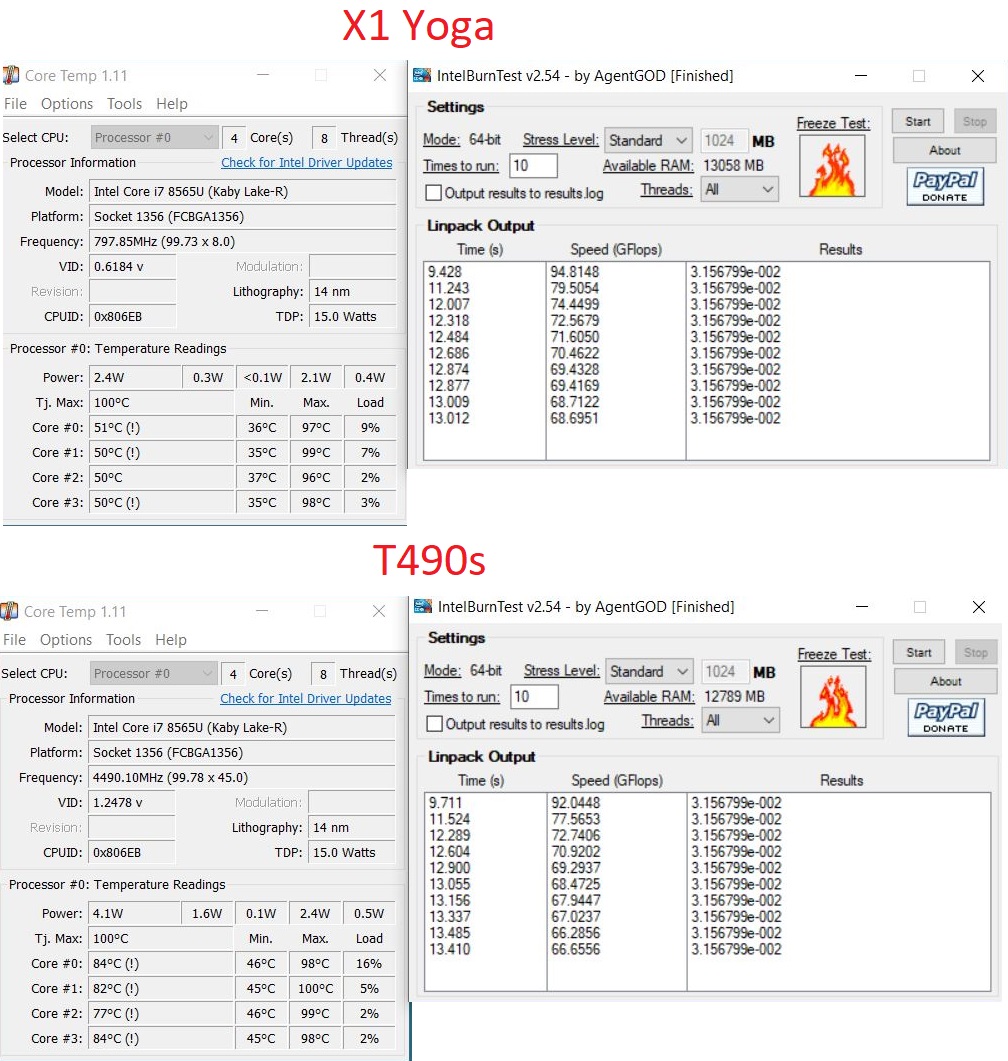
Figure 15: Intel Burn Test
Looking at the results, I found some things interesting. Both machines completed the tests successfully; both got hot and hit similar maximum temperatures, which is fine for this sort of test. The elapsed times were similar.
There is always something that I would like to see changed in the next model. I have no idea how difficult this would be to implement or whether it is possible at all, but I would really like the facial recognition to be integrated into the pre-desktop authentication so that a face could provide all needed security. (This is the same wish I had last year.) None of the fingerprint readers work very well for me. My fingerprints are worn from years of my doing lots of strenuous things with my hands, small injuries and working with abrasives. The newer, square fingerprint readers are better for me than the older, slit-type readers, but other than being older and grayer, facial recognition would be a better alternative for me.
I think the Thinkpad T490s would be an excellent choice for anyone needing a light-weight, high-end, traditional business laptop.
